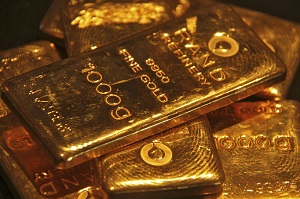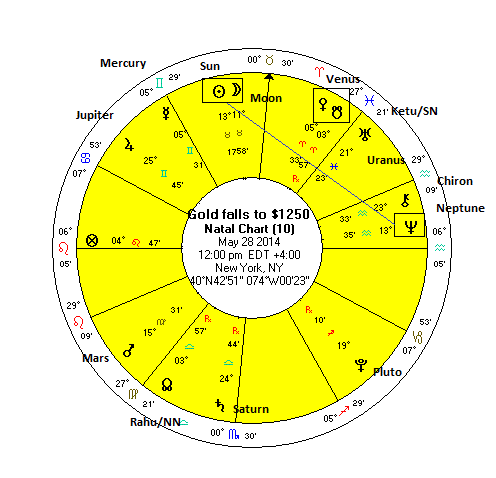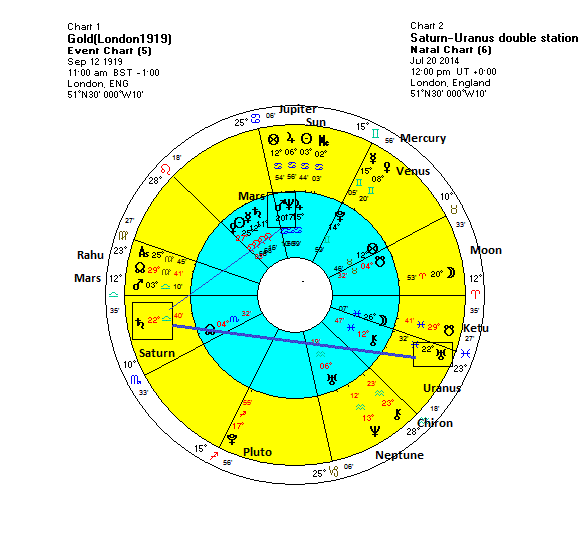 (1 June 2014)
As the old saying goes, all that glitters is not gold. Perhaps
including gold itself. The safe haven precious metal of choice decline
sharply last week as it broke through an important technical support
level. Deflationary fears compelled more investors to hit the sell
button, as gold finished the week at $1250. As a traditional hedge
against inflation and currency debasement from central bank money
printing, gold is now the commodity that nobody wants. The Federal
Reserve is tapering its controversial QE program and thus reducing the
amount of its own money printing. Strike one for gold. Inflation is
not much of a threat in most developed economies as Europe remains mired
in recession with sub-1% inflation and the US revised its Q1 GDP
figures down to -1% with only 1.5% inflation. Strike two for gold.
Last week, Japan released new data that showed sharply lower retail
sales which would similarly reduce growth prospects for the current
year. That could well add up to strike three for gold.
(1 June 2014)
As the old saying goes, all that glitters is not gold. Perhaps
including gold itself. The safe haven precious metal of choice decline
sharply last week as it broke through an important technical support
level. Deflationary fears compelled more investors to hit the sell
button, as gold finished the week at $1250. As a traditional hedge
against inflation and currency debasement from central bank money
printing, gold is now the commodity that nobody wants. The Federal
Reserve is tapering its controversial QE program and thus reducing the
amount of its own money printing. Strike one for gold. Inflation is
not much of a threat in most developed economies as Europe remains mired
in recession with sub-1% inflation and the US revised its Q1 GDP
figures down to -1% with only 1.5% inflation. Strike two for gold.
Last week, Japan released new data that showed sharply lower retail
sales which would similarly reduce growth prospects for the current
year. That could well add up to strike three for gold. Since the meltdown in 2008, governments have tried to stimulate their sagging economies through various Keynesian spending measures (e.g. TARP) and central bank interventions which has the net effect of printing money. These government efforts were the main reason why gold more than doubled in price from $800 in 2008 to over $1900 in September 2011. The bull market in gold was primarily fueled by the expectation that all this government spending and money printing would create inflation. Since gold is a hedge against inflation, many investors bid up the price in order to protect against a potential decline in the purchasing power of their own paper currencies. The problem is that the inflation never happened, at least not in the developed world. Emerging markets such as India, China and the Middle East did suffer a serious bout of inflation, in part due to the actions of central banks in the US and the EU. However, most developed economies were so mired in debt and excess labor supply (i.e. unemployment), that it seems that no amount of government stimulus could resuscitate those economies so that any kind of inflationary dynamic took hold. Without inflation and with central banks taking more of a hands-off approach, there isn't much reason to own gold. At least not in the short term.

Gold's decline this week correlated with two difficult planetary alignments involving the main planetary proxies for gold, Venus and the Sun. Tuesday's Venus-Ketu conjunction is a kind of wild card pairing with value-seeking Venus conjoined with anti-materialist Ketu (the Sanskrit name for the South Lunar Node). While not always negative for gold, the Ketu influence increases the possibility of a decline. Wednesday's Sun-Neptune square aspect is a higher probability negative influence on gold since Neptune tends to weaken whatever planets its aligns with. The Sun has a strong symbolic connection with gold so any weakness conferred to the Sun will usually manifest as a decline in the gold price. That Neptune influence was a central reason why I predicted more downside for gold in last week's investor newsletter.
In a previous post, I suggested that gold likely had further to fall and did not look like a good investment for 2014. So far, this prediction has been borne out as gold has fallen from $1380 in March to $1250 now. I noted a difficult tertiary progressed pattern in the summer that might coincide with a low point. Given the fairly generous margin of error with progressions, it is difficult to pin down just when this low might occur. It seems unlikely that we are there yet, however, so I would expect gold to fall further from its current level.

The upcoming Saturn-Uranus double station on July 20-21 could be a significant marker for gold and many other financial markets. This is an extremely rare celestial event which bears close watching. It is unusual enough that two outer planets like Saturn and Uranus should change direction within one day of each other. But what makes this Saturn-Uranus double station extra-special is that the two planets will be in a close 150-degree alignment with each other. As a rule, planets that form angles that are multiples of 30 degrees will have more of an impact of collective sentiment. Since Saturn is one of the two planets involved here, there is good reason to expect pessimism and caution to be front and center around this pattern. The fact that Saturn (22 Libra) will form a fairly close square aspect to the natal Mars (20 Cancer) in the Gold 1919 chart offers more reason to expect that gold prices will continue to be under pressure.
Financial Markets Update
US stocks extended their winning ways last week as the Dow closed at a new all-time high of 16,717. The economy may not be recovering fast enough to cause inflation or any kind of wage growth but it is still fast enough for Wall Street. Indian stocks saw some profit taking as modest GDP projections for the year dampened the post-election euphoria. The Sensex lost 2% closing at 24,217. As expected, we did see some early week gains across the board on the Mercury-Venus-Ketu aspect while more weakness was evident around the midweek Sun-Neptune square.
This week may revolve around the effects of next Saturday's Mercury retrograde station (June 7). Markets will be closed when Mercury reverses, of course, but its effects could manifest at the end of the week. The key is not so much that retrograde stations are bad (or good) but that this one occurs while forming an exact 135-degree angle with bearish Saturn. To be sure, the 135-degree angle doesn't have the same probable impact of the 90 or 180 degree angles, but it may be worth watching nonetheless. The first half of the week has the Sun aligning with Uranus and Pluto which can sometimes indicate greater collective confidence and hence, rising prices.
